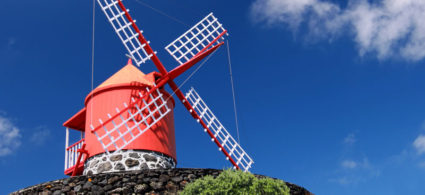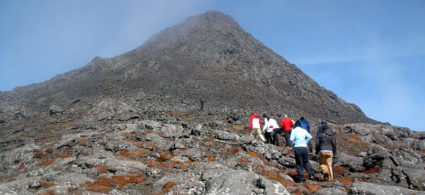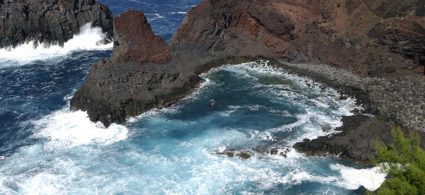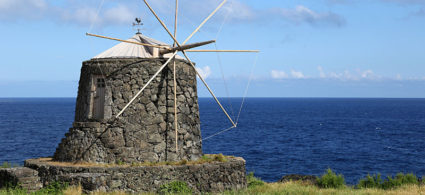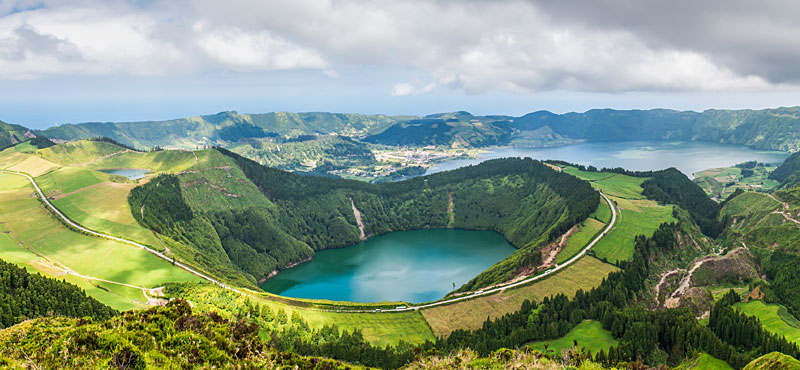

The Azores Islands, famous for the homonymous anticyclone that conditions the weather of the whole Europe, are an archipelago in the middle of the Atlantic Ocean, autonomous region of Portugal.
Of volcanic origin, lush, mountainous and wild (Mount Pico with its 2351 meters is the highest peak in Portugal), are softened by a thick vegetation dotted with incredible bushes of hydrangeas.
The Azores are islands of a unique beauty, an authentic paradise on earth, especially for those who love nature and active vacations, thanks to the numerous trekking routes and marine activities. Dolphins, turtles and whales wander in fact for the surrounding waters, making the joy of tourists who can systematically spot them during a boat trip.
Once half unknown to most, only in recent years have become a popular tourist destination, fortunately still remaining authentic and preserving their wild character.
Usually those who visit them for the first time tend to return, thanks to the rare beauty and great diversity between one island and another. Among all of them, São Miguel is the most visited island of the archipelago and certainly the main gateway, thanks to the highest number of air connections.
The Azores archipelago is located in the Atlantic Ocean, 1403 kilometers from the coast of Portugal, 880 kilometers from Madeira and in fact halfway between Europe and North America.
The Azores are composed of 9 islands, all of volcanic origin, divided into three geographical groups: Graciosa, Terceira, São Jorge, Pico and Faial in the central part, Flores and Corvo in the west and São Miguel and Santa Maria in the east.
Nine islands, nine small worlds: in common the volcanic origin and a cordial hospitality. These are the Azores, an oasis of rare beauty in the vastness of the Ocean.

São Miguel, the largest island and also the most touristic, is covered by luxuriant subtropical forests that have earned it the nickname Ilha Verde and boasts two beautiful lakes and thermal springs in the Furnas Valley.
Its capital, Ponta Delgada, is also the gateway to the archipelago thanks to its airport. Picturesque villages and historic towns line the steep, rocky coasts of the island. Some beautiful sandy coves can be found along the gentler southern coast. Sao Miguel is just over a 2-hour flight from Lisbon.
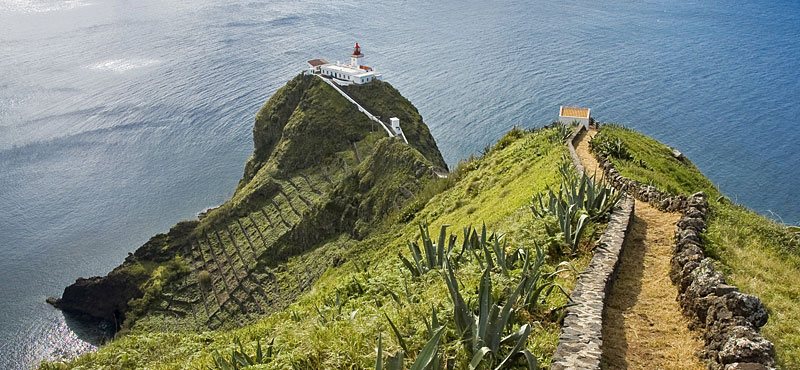
Santa Maria, the third smallest, southernmost and easternmost island in the Azores, is a tranquil island full of protected bays, white sandy beaches lapped by warm waters and an enchanting hilly landscape.
Known as Yellow Island, Santa Maria boasts a pretty capital, Vila do Porto, and a few picturesque villages such as Santa Bárbara, Santo Espírito, São Pedro and Almagreira. A small airport makes connections easy.

The island of Terceira is the third largest in the archipelago and is home to the historic capital of the Azores, Angra do Heroísmo, dating back to 1534 and now listed as a UNESCO World Heritage Site.
The fortifications of San Sebastian and San João Baptista, dating back to 1600, are unique examples of military architecture. The plan of the city was made according to the winds. The island’s villages are located along the southern coast, the gentlest, and are closely linked with the sea, while the hinterland is uninhabited and wild.

Among the most popular islands of the Azores, Faial is famous for its beautiful volcano, the Caldeira, surrounded by beautiful blue hydrangeas. In the western part is Capelinho, a small volcano with a lunar landscape, while the eastern part offers an enchanting landscape characterized by gentle slopes.
The renowned bay of Port Pim, a historical place of whales, is ideal for swimming and sunbathing and the exceptional caves of Costa da Feteira and the viewpoint of Monte da Guia. The bustling capital of Horta was for centuries an important port for trade between Europe and America and holds a unique atmosphere.

The island of Pico, known for the highest mountain in Portugal, the Pico Volcano, from which to enjoy a unique view of the central group of the archipelago, is full of lakes and boasts a unique lush vegetation. The island, the second largest of the Azores, is cultivated with vines, fig trees and orchards.
The town of Lajes, the old Sao Luis founded in 1460, is located within a beautiful protected bay. To the whalers of the island of Pico Herman Melville dedicated the novel Moby Dick. Don’t miss the whale watching excursions.

Sao Jorge is the most solitary and unspoiled island of the Azores archipelago and can be reached by ferry from Pico in 3 hours. Almost all the villages on the island of Sao Jorge are located at the foot of high cliffs in the small coastal plains.
In addition to the wonderful natural wealth, the island is famous for the best hiking in the Azores, Sao Jorge offers stunning views of the other islands of the archipelago.

Deep valleys and high peaks characterize the lush center of the island of Flores, the westernmost of the Azores together. So rich in fauna that it is named after the flower, the island is the rainiest in the archipelago.
Along the dramatic coastline of Flores you can admire hundreds of picturesque waterfalls and of particular beauty the Lagoas, the area with 7 lakes of volcanic origin.

Also known as the White Island, Graciosa is the northernmost of the archipelago’s central group and is a place of tranquility and peace. Graciosa is the second smallest island of the archipelago and enjoys the best climate due to the absence of real relief since its caldera reaches only 402 meters above sea level. Wide valleys, gentle terraced slopes and picturesque windmills characterize its landscape.
Due to its dry climate, villages can be found not only on the coast but also inland. The traditional houses in the capital Santa Cruz glow in their whitewashed glory. To the southeast of Graciosa is a large volcanic crater which contains a huge cave, Furna do Enxofre, and an underground volcanic lake.

Corvo is the smallest island of the Azores archipelago, a verdant volcanic cone that seems to come out of nowhere among the waters of the Atlantic Ocean.
Vila Nova do Corvo is the only settlement on the island, a picturesque town where only a few hundred people live, marked by houses with dark stone facades. Isolated and quiet Corvo is embellished by small windmills.
In the following map you can see the location of the main places of interest mentioned in this article.
When planning your trip, unless you have at least a month to spare, you’ll need to choose which islands to visit. Usually with a couple of weeks you can see 4 or 5 islands (running around a bit).
Most people who visit the Azores for the first time, usually always include the two main islands, Sao Miguel and Terceira, and 2 or 3 of the central islands, Pico, Sao Jorge and Faial. A choice dictated mainly by the proximity and therefore the ease of movement between these islands, because islands like Flores or Graciosa have nothing to envy to the others.
In general, the minimum time that we recommend you devote to each island is:
Consider them as full days, thus adding the time needed for travel. You now have a starting point to compose your itinerary, bearing in mind, however, that connections with the most distant islands (Flores and Corvo in particular) are less frequent.
The Azores islands are located in the Atlantic Ocean and although they are not particularly famous for their beaches they offer some of the best conditions in the world for surfing, windsurfing and kitesurfing. The water temperature is mild throughout the year thanks to the action of the Gulf Stream.
The islands of the archipelago have mostly dark sandy, due to their volcanic origin, and rocky beaches.
Theisland of Santa Maria encloses the most beautiful beaches of the archipelago of the Azores, with expanses of light sand bathed by warm waters. Among the best beaches we find Sao Lourenco, shaped like an amphitheater and surrounded by vineyards, the white sand beaches and natural pools near Anjos in Vila do Porto, Praia Formosa and Maia.
The black sand beach of Praia do Populo is located on theisland of Sao Miguel, near the town of Sao Roque, about 15 minutes drive from Ponta Delgada. Near the beautiful fishing village of Calorua is the beach of Ribeira Quente.
Water sports lovers will especially appreciate the hollow and challenging winter waves, ideal for any surfer. In addition, the town of Praia da Vitoria, on the island of Terceira, is home to the world championship of windsurfing and slalom.
Learn more about the beaches of the Azores
The Azores islands have a subtropical oceanic climate, with a reduced temperature range between summer and winter: it goes from an average daytime of 15/17 ° C in winter to 24/26 ° C in the hottest months. The thirty degrees are reached very rarely, in compensation the nighttime temperatures never go down below 7/8 degrees.
The recommended period to visit the Azores goes from June to September. For further information we advise you to consult the page Azores Weather.
There are direct flights from the rest of Europe, the most comfortable solution is to make a stopover in Portugal.
If there is no direct flight, you can choose to fly with the Portuguese national airline TAP, whose flights include a stopover at Lisbon or Porto airport, and then go directly to São Miguel or Terceira.
Alternatively, you can book two separate flights, for example a low-cost flight to Lisbon and then a flight to any of the islands of the archipelago, thanks to the more extensive connections offered by SATA, the Azores’ airline. TAP and Ryanair also offer frequent flights from Portugal to the Azores, but they do not reach all the islands.
If your intention is to visit only the Azores, the first solution will allow you to save a lot of time, if instead you want to break with a visit to Lisbon or Porto, choose the second option.
For further information we suggest you to consult the page Flights to the Azores.
The fastest way to move between the islands is to use the plane, thanks to the daily flights offered by SATA. Each island has its own small airport and the prices of internal flights range between 70 and 90 euros one way. We advise you to book your internal flights well in advance to avoid the risk of being stranded. The current connections struggle to meet the tourist demand, especially in high season, so better not to risk.
Alternatively, and depending on the time of year and sea conditions, it is possible to move by ferry with the ships of AtlanticoLine, but it is a convenient solution only to move between the central islands (Faial – Pico – Sao Jorge), as the routes are short and frequent. The other routes are very long and can be a problem, especially if you suffer from seasickness. In winter most of the longer routes are suspended or greatly reduced.
In our opinion, there is only one way to visit the Azores comfortably and well: rent a car. Almost everything there is to see is difficult to reach by public transport, if not impossible. Having a car allows total autonomy, a huge saving of time and the flexibility needed to better organize your trip, which especially because of the extremely changeable weather, will lead you to change your plans several times.
Otherwise, you should know that in Sao Miguel and Terceira there are several bus lines, but they are few and infrequent in the other islands instead practically do not exist. Alternatively, you can get around by cab, which are always available at the arrival of ferries and outside the airports. If you want you can organize directly with them your stages, but keep in mind that the final cost will be much higher than renting a car.





